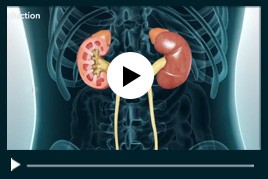Hydrocele/Spermatocele
A hydrocele is an accumulation of fluid around the testicles causing the scrotum to swell. This is caused due to non-closure of the tube through which the testicles descend into scrotum. Non-closure of the tube leads to accumulation of fluid in the scrotum. Inflammation or injury of the testicles, or blockage within the spermatic cord by fluid or blood may also cause hydrocele. This condition usually disappears after few months following birth. If the condition does not disappear, the child may develop hernia, where a section of the intestines runs through the still-opened pathway. If the child develops hernia minor surgery may be needed.
Hydrocele is most common in the new born infants. Individuals suffering from hydrocele may present with painless, swollen testicles feels like water balloon, occurring on one or both sides of testes.
Diagnosis
Hydrocele is diagnosed by trans illumination. This technique involves placing a small light source through the enlarged portion of the scrotum. If a hydrocele is present, the scrotum will light up. Also, an ultrasound can be done to detect presence of hydrocele in scrotum.
Types
There are two types of hydroceles:
- Communicating: They are present at birth. The hydroceles connect with the scrotum and abdomen.
- Non-communicating: This condition may be present at birth or develop year’s later. There is no form of connection with the scrotum or abdomen.
Management
Aspiration is alternate treatment option to drain out the fluid in scrotum. In this process, the fluid is removed using a needle. Risks associated with aspiration include infection, fibrosis, mild to moderate pain in the scrotum, and recurrence of hydrocele.
Surgery is done if hydrocele is large causing discomfort and cuts the blood supply to testicles.
Hydrocelectomy
Hydrocelectomy is a surgical procedure to treat a hydrocele and prevent its recurrence. The procedure is performed under general anaesthesia. In infants a small incision is made in the groin (area where the upper thigh meets the trunk), and in adults the incision is made on the scrotum. The fluid is drained after removing the part of the sac. Incision is closed with dissolvable stitches.
Sometimes a laparoscope is used for this procedure. A Laparoscope is a tube like instrument having a tiny camera at the end of the tube. A camera is attached to the monitor to display larger images of the procedure. Small surgical instruments are inserted through the other incisions and repair or removal is done.
Risks associated with surgery include bleeding, infection, and injury to the scrotal tissues while performing the surgery.
Patients should avoid eating and drinking for at least 6 to 8 hours before the surgery. Medicines such as aspirin, ibuprofen (Motrin, Advil), naproxen (Naprosyn), and herbal supplements should be stopped before the surgery.
Spermatocele
A spermatocele is an abnormal fluid-filled sac or cyst that arises in the epididymis, a coiled tube located above each testicle that stores sperm. The fluid in the sac is clear or white and may contain sperm. Spermatoceles are usually noncancerous, painless and do not affect fertility. They usually produce no symptoms unless they grow to cause discomfort, a feeling of heaviness, a palpable mass or pain. They usually present in men in the age group of 20 to 50, due to blockage of the epididymis as a result of trauma or inflammation.
To diagnose a spermatocele, your doctor will examine and palpate your testicles. A trans illumination examination may be performed where a light is passed through the testicles to indicate if the mass is solid or contains fluid. An ultrasound test, which uses sound waves to create images of the testicles, may also be performed.
If your spermatocele produces pain, your doctor will first prescribe pain medication. If the discomfort is still intolerable and the cyst is growing, a procedure known as spermatocelectomy may be performed to separate the spermatocele from the epididymis. Another procedure that is performed is aspiration of the spermatocele fluid possibly followed by introduction of a substance that induces scar formation to avoid recurrence. These procedures, however, can sometimes cause damage to the epididymis, thereby affecting fertility.

 Menu
Menu




